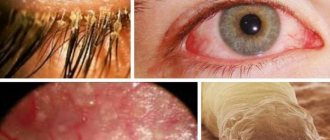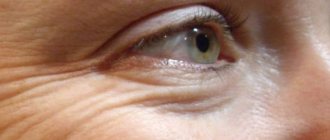Redness, pain and itching in the corners of the eyes can indicate visual fatigue. But sometimes such symptoms are caused by inflammation of the lacrimal sac. Dacryocystitis develops due to complete or partial blockage of the lacrimal canal. Infections and injuries can provoke this phenomenon. Often the cause of this pathological condition is an abnormally narrow or tortuous tear duct. Inflammation of the lacrimal sac must be treated as quickly as possible, since the disease can quickly develop into a chronic form.
Causes of tear duct obstruction
Normally, after washing the eye, the tears of a healthy person flow to the inner corner. Through the lacrimal openings they pass into the lacrimal canal, flow into the lacrimal sac and exit into the nasal cavity. With dacryocystitis, this process is disrupted; the tear fluid, stagnating, loses its antibacterial properties, and infectious agents develop in it, causing inflammation.
In children, the reasons for the development of ophthalmological pathology are as follows::
- gelatin-like plug that did not resolve after birth;
- blockage of the tear duct;
- narrow lumen of the nasolacrimal passage.
In adults, dacryocystitis appears for the following reasons::
- swelling of the tissues of the nasolacrimal area due to nasal polyposis or sinusitis;
- traumatization of the lacrimal canal or the area next to it.
Swelling above the eyes
Puffiness above the eyes, especially in the morning, is a common problem that many adults and children regularly face. Some people are not bothered by it at all, and people are not going to do anything. But the majority are at least dissatisfied with their stale, tired appearance and would like to find out why swelling of the eye occurs from above and in what ways it can be removed, if not quickly, then at least for a long time. Let's look at the most common causes of this phenomenon and methods to combat it.
For reference: edema is the accumulation of fluid in tissues or organs; in this case, if we are talking about the eyes, edema means the accumulation of fluid in the intercellular tissue space or in the dermal cells themselves. The skin around the eyes is very sensitive and reacts instantly to any external irritants or internal disturbances. Its cells, like a sponge, draw in moisture and retain it. This manifests itself as swelling, which is not always easy to get rid of quickly - it all depends on the cause.
Classification and symptoms
Based on the nature of its course, dacryocystitis is divided into acute and chronic. Due to its appearance, obstruction of the lacrimal canal can be chlamydial, allergenic, traumatic, or viral. Clinical signs vary depending on the form of the disease.
Acute dacryocystitis has the following striking symptoms:
- swelling of the eyelid;
- fever;
- compaction of the lacrimal sac, “fat lumps” near the eyes;
- hyperthermia of the skin near the lacrimal canal.
A constantly clogged tear duct leads to a rapid transition from acute to chronic dacryocystitis. This form is characterized by ongoing inflammation of the lacrimal sac. The resulting tumor softens, hyperthermia decreases, and an abscess forms, which can open on its own. Purulent exudate flows out of it, after which the inflammation subsides.
Treatment methods for swelling of the upper eyelid
Treatment of edema of the upper eyelid is directly related to its cause; depending on it, methods and treatment regimens will be determined.
- If it’s all about the inflammatory process, then they can prescribe antibacterial and anti-inflammatory drugs of systemic and local action, as well as physical procedures that enhance the effect of medications.
- In case of injury, if it occurred no more than a day ago, a cold compress is first applied to the eye. The open wound is treated with antiseptic and anti-inflammatory agents. To prevent the spread of infection, your doctor may prescribe antibacterial eye drops. Further measures depend on how extensive the damage is and whether other organs need to be treated.
- If swelling is caused by an allergy, you should definitely find out what exactly the irritating allergen is. The easiest way to do this is with allergy tests. After this, contact with the irritant is avoided as much as possible, and antihistamines are selected. In severe cases of an allergic reaction, hormone therapy is performed.
For diseases of the internal organs, accompanied by the accumulation of fluid in the tissues, treatment is prescribed depending on the diagnosis.
How to distinguish conjunctivitis from dacryocystitis?
Inflammation of the lacrimal sac is similar in external manifestations to many eye pathologies, including conjunctivitis. But when comparing the symptoms, certain differences can be identified. The following table shows the main differences.
| Sign. | Conjunctivitis. | Dacryocystitis. |
| Swelling of the eyelids. | Both eyelids swell predominantly and the swelling is insignificant. | There is swelling of the lower eyelid. If you press on the inflamed area, pus is released from the lacrimal openings. |
| Tearing. | Constant, but the tears are pure. The exception is bacterial conjunctivitis, in which there is purulent discharge in the tears. | Spontaneous and almost continuous (with pus). |
| Itching and burning. | They are characteristic symptoms. | Not observed. |
| Localization of pain. | The pain is localized throughout the eye or in its corner. | The source of pain is the lacrimal sac, which is located near the nose. |
| Temperature increase. | Absent. | Body temperature rises if inflammation affects blood vessels. |
| Spreading. | It gradually affects both eyes. | It is most often localized on one eye. |
Diagnostics
The diagnosis of “dacryocystitis” is made after an external examination and anamnesis. Further examination includes:
- Vesta sample. A tampon is inserted into the nostril on the side where the inflamed lacrimal canal is located, and a collargol dye solution is instilled into the eye. If everything is normal with patency, then within a couple of minutes the tampon will be colored. If this does not happen after 10 minutes, the West test indicates that the tear duct is clogged.
- Probing. The study reveals damage to the lacrimal canaliculi.
- Bacterial culture of a smear from the nasolacrimal duct. Bacterial analysis is necessary to identify the infectious agent.
Treatment of dacryocystitis in adults
Therapy is carried out exclusively by an ophthalmologist. In adults, the question of whether dacryocystitis can go away on its own disappears due to the reasons that provoked the pathology. It will not happen .
Medicines
Treatment for acute and chronic forms differs. Therapy is carried out in a hospital. Self-treatment is unacceptable; home therapy can lead to worsening of the condition.
Acute dacryocystitis can be treated with antibiotics. Drugs are selected depending on the type of bacteria that causes dacryocystitis. Tobrex, Oftaquix, Levomycetin, Ciprofloxacin, Albucid are usually prescribed.
Instillation of antibacterial drops is performed. This is Gentamicin, Miramistin. Antimicrobial ointments are placed behind the eyelid. When an abscess forms, it is opened and drained, followed by washing the cavity with antiseptic solutions.
Sometimes medicinal leeches are used in treatment. It happens that hirudotherapy for dacryocystitis is the only remedy that helps pregnant women. After all, many drugs are prohibited for them. Depending on the course of the disease, a different number of sessions may be required. Usually 3-4 sessions are required.
Surgical intervention
Chronic dacryocystitis is eliminated surgically, during which doctors create a new passage between the nasal cavity and the lacrimal sac. This ensures normal drainage of fluid through the lacrimal canal. In the most severe cases, they resort to removing the lacrimal sac.
ethnoscience
Treatment with folk remedies should only be used as an addition to primary therapy. There are many remedies that will help fight dacryocystitis.
- Kalancho juice. It helps remove blockages from the nasolacrimal duct due to its local irritant effect. To prepare juice at home, fresh leaves of the plant are cut, washed, dried and put in the refrigerator for a couple of days. This achieves the maximum level of concentration of nutrients in the plant. Then squeeze out the juice using a blender or juicer and dilute it half with saline. The juice is dripped into the nose, 10 drops at a time.
Folk remedies for treatment
There are many folk remedies that quickly help remove swelling of the eyelids and restore skin health. The recipes are simple and can be used at home. Effective therapies include:
- 1. Contrast lotions. For the procedure, you can use regular boiled water or herbal decoctions based on sage, mint, chamomile or arnica. It’s easy to prepare the mixture: for 1 liter of water you need to add 2 tbsp. l. medicinal plant. Boil for 5-7 minutes and let steep for another 5 minutes. Afterwards, the broth must be divided into two equal parts, one of which is strongly cooled. You should alternately apply a soaked cotton pad to the affected eyelid, first in a cold, then in a warm decoction. The procedure lasts about 10 minutes.
- 2. Parsley mask. The greens are crushed into a suspension and added in the amount of 1 tbsp. l. in 25 g of fat sour cream. Mixes well. The mixture should be carefully applied to the face and around the eyes. Leave on for a few minutes, then rinse with cool water.
- 3. Soda solution. To prepare the medicinal mixture, you need to add 1 tbsp. l. baking soda in 100-120 ml of cold boiled water. Thoroughly soak a cotton pad with the resulting solution and apply it to your eyelids for 10 minutes.
- 4. Fresh vegetable mask. It will require cabbage, potatoes and parsley (in equal proportions). Everything is carefully crushed and placed in small homemade gauze bags. They need to be applied to the eyelids and kept for a quarter of an hour.
- 5. Potato mask. This method will quickly relieve swelling if the cause is not a serious illness. To do this, you need to chop peeled raw potatoes and wrap the resulting pulp in gauze. Keep on the affected eyelid for 15 minutes.
- 6. Fresh cucumber. To do this method, you need to take two thin circles of the vegetable and apply it to your closed eyes. You should lie down and relax in a calm environment for 15 minutes. This method is especially effective when the eyelids above the eyes swell.
Features of therapy in children
A common cause of dacryocystitis in children is a membrane that should break at the first cry of the baby. If there is no rupture, the lacrimal canal remains sealed, and inflammation of the lacrimal sac develops.
Parents often wonder whether dacryocystitis can go away on its own in a child? Yes. Sometimes the film does not break immediately, but after a couple of weeks or even months, and the obstruction of the lacrimal canal resolves itself.
Massage of the tear duct
A pediatrician should teach parents how to effectively massage. There is nothing complicated about technology. You need to move your finger from top to bottom from the corner of the eye and the bridge of the nose (10 repetitions) with slight pressure. You need to finish the session with light vibration movements in the area of the lacrimal glands. It is necessary to carry out a special massage for 14-21 days.
The best drugs
Massage is combined with the following means:
- Albucid. Eye drops that effectively destroy the causative agent of dacryocystitis.
- Collargol. The drug is dripped 4 times a day until the condition improves.
- Signicef. An antibacterial drug belonging to the group of fluoroquinolones. For dacryocystitis, children over 9 years of age and adults are recommended to instill one drop every 2 hours for the first 3 days. Then 4 times a day for 5-14 days (to be agreed with the doctor).
- Furacilin. A well-known antimicrobial drug, the solution of which is recommended to wash the eyes with dacryocystitis to eliminate pus.
- Tobrex. An antibacterial drug that is used in courses, as addiction occurs and sensitivity to it is needed to be restored.
- Vitabact. Vitabact for dacryocystitis is used to wash the eyes. Judging by the reviews of experienced mothers, the drug is weak and gives a positive result in combination with Tobrex or Fucithalmic. Apply twice a day for a course of 10 days.
Homeopathy
Many traditional healers claim that they know how to cure dacryocystitis with homeopathic medicines.
For dacryocystitis, homeopaths recommend the following remedies:
- Argentum nitricum 30. 7 balls are dissolved in 1/3 glass of water. Give a teaspoon 7 times a day.
- Pulsatilla 6. The granule is dissolved in 1/3 glass of water and the solution is given a teaspoon to the child every 2 hours for 2 days.
- Silicea 6. This homeopathic remedy is alternated with Pulsatilla 6, conducting similar therapy every 2 hours until the condition improves.
- Argentum nitricum 12. One granule of the product is dissolved in a dessert spoon of water and given to the child once.
Why do the eyelids above the eyes swell?
Bags over the eyes are not such a surprising phenomenon. Both men and women meet with him regularly – some more often, some less often. It is not customary to pay attention to this problem. The bags above the eyes, of course, do not look very attractive, but in the morning they can be disguised with cosmetics, and at the end of the day the swelling will disappear on its own. Of course, no one thinks about why the eyelids above the eyes swell. And in vain - there are many reasons for the appearance of bags over the eyes. And some of them may even pose health risks!
Why do the upper eyelids swell?
The eyeballs are held in the sockets by special layers of fat, which, in turn, are attached to a small connective membrane. Numerous studies have helped establish that bags above the eyes appear due to a sharp increase in fat and stretching of the membrane. The latter protrudes outward, creating swelling.
There are two main types of swelling of the upper eyelid:
- Inflammatory swelling is accompanied by redness and pain. Small lumps may form under the skin. Inflammatory swelling occurs due to vasodilation.
- Non-inflammatory swelling is painless and causes virtually no discomfort. Such swelling most often occurs in the morning. The main difference is that swelling appears simultaneously on both eyelids. When blood flow is normalized, non-inflammatory edema tends to resolve.
The main causes of swelling of the upper eyelid
The most common causes of bags over the eyes are as follows:
- Many people have swollen eyelids due to the growth of fatty tissue in the eye socket. This problem is transmitted at the genetic level and often manifests itself from a young age.
- If the swelling is heterogeneous, and a small dot is visible in the center, most likely the cause is an insect bite.
- In some women, the cause of swelling of the upper eyelid may be a hormonal imbalance. Sometimes swelling appears at a certain period of the menstrual cycle and disappears on its own after a few days.
- Reactions to low-quality cosmetics or allergies to some of their components very often manifest themselves as swelling of the eyelids. Often the skin around the eyes reacts to tattooing in a similar way.
- Bags also appear over the eyes in those who ate too much salty food the night before or drank too much liquid. In people who constantly abuse salt, swelling almost never goes away.
- It happens that swelling on the upper eyelids occurs after sunbathing or a session in the solarium.
- The upper eyelids may become swollen if the skin becomes less elastic and firm. The reason for this phenomenon is age.
- Some representatives of the fair sex have bags over their eyes due to fatigue.
- Bad habits, poor diet, unhealthy lifestyle - all this can also cause the problem.
Why do the eyelids above the eyes still swell?
There are other reasons why the upper eyelids may swell: illness. The following ailments can provoke the appearance of bags over the eyes:
- infections;
- kidney disease;
- sinusitis;
- frontal sinusitis;
- fever;
- increased intraocular pressure;
- hernia of the eyelids;
- blindness;
- glaucoma;
- flu;
- angina;
- diseases of the cardiovascular system leading to circulatory disorders;
- erysipelas;
- ascites;
- injuries.
Before you begin treatment for puffiness of the upper eyelids, you need to accurately determine the cause of the problem. In most cases, you can get rid of the hated bags with the help of special ointments or drops.
How to treat infectious inflammatory diseases of the eye?
For inflammatory eye diseases of a bacterial nature, doctors recommend starting treatment immediately when the first symptoms appear. For example, the broad-spectrum antimicrobial agent ofloxacin, from the group of second-generation fluoroquinolones, has proven itself to be effective; it is embedded in the cell walls of bacteria and blocks the work of enzymes responsible for the reproduction of DNA molecules, after which the bacteria lose the ability to reproduce and die. Ofloxacin is the active ingredient of the drug Floxal, which is available in the form of eye ointment and drops and has a pronounced antibacterial effect. For barley, antibacterial ointment is applied to the inflamed area, the characteristic swelling of the eyelid, at least 3 times a day until the symptoms disappear completely, but for at least 5 days even if the symptoms disappeared earlier. For bacterial conjunctivitis (red eye with purulent discharge), drops are instilled 2-4 times a day until symptoms disappear completely, for at least 5 days in a row.
Prognosis, complications, prevention
Dacryocystitis is not often diagnosed in ophthalmological practice (only 5-7%). But despite its rarity, the disease poses many risks to the patient’s health. Dacryocystitis is not a fatal diagnosis. Its outcome and prognosis for the patient's future life are favorable.
Sometimes complications develop:
In this case, there is a risk of the patient becoming disabled. Preventive measures include timely examination and treatment of ENT organs, consulting a doctor if you receive cranial or eye injuries.
Video about the disease
Watch the episode of the “Live Healthy” program with Elena Malysheva, dedicated to the symptoms and treatment of dacryocystitis.
Author of the article: Bakhareva Elena Sergeevna, specialist for the website glazalik.ru Share your experience and opinion in the comments.
If you find an error, please select a piece of text and press Ctrl+Enter.
The glands of the lacrimal system perform a number of functions that prevent the development of many diseases of the organs of vision. The secretion produced is needed to moisturize the mucous membranes of the nose and eyes, disinfect, nourish the cornea, and wash away microorganisms and foreign objects that have gotten under the eyelids. Violation of these functions (including those associated with inflammation of the lacrimal sac) is fraught with temporary or chronic vision loss, and therefore requires immediate consultation with an ophthalmologist and treatment.
Causes of inflammation of the lacrimal sac or dacryocystitis
The causes of dacryocystitis in children can be:
- “mumps” (acute mumps);
- scarlet fever;
- acute respiratory and infectious diseases;
- flu;
- pneumonia;
- tumors;
- neuroses.
- previous orbital and nasal fractures;
- eyeball injuries;
- damage to tear ducts;
- clogged eyes.
Contributing factors in adults are:
- tuberculosis;
- metabolic disorders;
- diabetes;
- weak immunity;
- working with chemicals.
Instructions for Visomitin eye drops are presented here.
Dacryocystitis can develop into a chronic form with syphilis, systematic pathologies of connective tissue, and Sjögren's Syndrome.
Symptoms of the disease
There are chronic and acute forms of pathology. Chronic – divided into types, depending on the type of lacrimal gland disorders:
- aplasia (lacrimal gland is absent);
- hypoplasia (not fully formed);
- hypertrophy (increased in size).
The symptoms of the pathology are somewhat different. The clinical picture of the chronic type is manifested in:
- increased lacrimation;
- heat;
- discharge from the neoplasm of mucous and purulent exudate;
- swelling of the conjunctiva and lacrimal sac;
- painful sensations;
- narrowing of the palpebral fissure.
In the acute form it is expressed more clearly:
- the skin adjacent to the lacrimal sac turns sharply red;
- swelling appears, causing pain when touched;
- the palpebral fissures are completely or almost completely closed;
Signs of corneal inflammation and ways to eliminate it - viral keratitis of the eye.
In acute dacryocystitis, fever, general weakness, chills, eye pain, and fistula formation are possible.
Symptoms and treatment of viral conjunctivitis in adults are described in the article.
Diagnostics
The diagnosis should be made by an ophthalmologist based on a visual examination, palpating the inflamed lacrimal sac and studying the patency of the lacrimal ducts using a canalicular test (Vesta). The latter procedure is based on inserting a tampon into the nose while simultaneously instilling a collargol solution into the eye.
With good patency, the pigment stains the tampon in 60-120 seconds, with difficult patency - within 5-10 minutes. A tampon that is not colored after 10 minutes indicates a blockage of the lacrimal ducts.
Children can undergo a passive nasolacrimal test.
But this article will help you recognize the symptoms of temporal arteritis and begin treatment.
In addition to probing the tear ducts, diagnostics include:
- living eye microscopy;
- fluorescein instillation test;
- bac sowing
Effective antimicrobial therapy - original and analogues of Vitabact eye drops.
How to remove bags under eyes with exercises
You can get rid of bags under the eyes by systematically stimulating the orbicularis oculi muscle. Do face-building for 20 minutes a day, and within a week the bags under your eyes will decrease.
Start the set of exercises with an eye warm-up - blinking. Open your eyes wide, don't squint when closing them. If your eyebrows move during blinking, hold them with your fingers.
Do a few head circles to improve blood circulation.
- Strengthen the inner eye muscles : move your pupils in a vertical figure eight pattern. Change the direction of the figure eights every 20 seconds. The exercise lasts 3 minutes.
- Place your ring fingers on your lower eyelids, your middle and index fingers on your forehead, and your little fingers on your cheek. Grab your head tightly. Inhale through your nose and roll your pupils up. Stay in this position for 10–15 seconds. Exhale through your mouth while looking down. Repeat 30 times.
- Do the previous exercise by changing the direction of your gaze. Inhale up to the right ear, exhale up to the left.
- Place your index fingers on your nasolabial folds. Say the sounds loudly: O, I, E, U, A. Open your mouth wide: you will feel tension in the lower part of the orbicularis oculi muscles.
- Place your index fingers on the border of the under-eye bags and press lightly. Close your eyes and start squeezing and unclenching them quickly. Continue for 1.5 minutes.
To keep your eyes beautiful, pay attention to the condition of your upper eyelid. We have already discussed how to remove a drooping eyelid in this article .
Treatment
The approach to eliminating the problem depends on the age characteristics of the patient.
In newborns
Treatment of dacryocystitis in newborns is carried out in stages:
- Massage for dacryocystitis in newborns (with reasonable effort, making 6-10 vertical movements after each feeding).
- Toilet the eyes by rinsing with furatsilin solution (1 tablet per 200 ml of hot water). The palpebral fissure is treated with a cotton swab soaked in the solution, moving from the temporal bone to the nomus. The final stage is the use of an antibiotic (levomycytin 0.25%).
A simple way to prevent any illness is vitamin eye drops.
In isolated cases, conservative treatment may not bring a positive result; then, under local anesthesia, a special probe is inserted into the lacrimal canal, and the paths are washed with an antiseptic solution. The procedure is safe, but requires preliminary preparation (general blood test, pediatrician’s report).
For instructions on Vitapos eye ointment, see the link.
In children
The acute form of inflammation in older children is treated in a hospital setting. Children are prescribed multivitamins and UHF therapy until symptoms of fluctuation are observed; later, the purulent inflammation is opened and drains are placed with a 10% sodium chloride solution. Over the next 3-7 days, the opening site is treated with antiseptics and lubricated with healing ointments. Massages are carried out at the same time.
For up to 10 days, use antimicrobial drugs (Gentamicin, Levomycetin, Tsipromed, etc.), antibacterial ointments, antibiotics:
- Oxacillin;
- Gentamicin.
- Cefotaxime;
- Cotrimoxazole.
- Urotropin;
- Solutions of hemodez, glucose 5%, ascorbic acid, calcium chloride 10%.
Positive trends from treatment should occur within 7-14 days, otherwise the lacrimal ducts are passively washed with a solution of furatsilin in a ratio of 1:5000.
If the healing process is not observed, manipulation is carried out using a Bowman probe under local anesthesia (for patients under 5 months) or under general anesthesia (for all others).
Operation
Children over 1 year of age can undergo balloon dacryocytoplasty. The operation involves inserting a thin conductor with a small liquid-filled balloon through the corner of the eye into the nasolacrimal canal. At the point where the channel is blocked, the balloon expands under pressure, clearing it. Infection is prevented by instilling eye drops and antibiotic medications prescribed by a doctor.
To prevent the formation of a purulent corneal ulcer during dacryocystitis, it is forbidden to touch the cornea. The taboo applies to any ophthalmological manipulations - ultrasound of the eye, wearing contact vision correction devices, tonometry, etc.
Find out how to treat inflammation of the cornea here.
Prevention
Preventive measures include a systematic examination by an ophthalmologist and otolaryngologist, and maintaining eye hygiene. If the recommendations are followed, the likelihood of inflammation is minimal, and the treatment process proceeds without complications.
Inflammation of the lacrimal sac is a common painful process that occurs in people of any age. It requires immediate diagnosis and qualified treatment, otherwise it can have fatal consequences, including inflammation or brain abscess, purulent encephalitis and other similar complications.
Video
This video will tell you how to deal with inflammation of the lacrimal sac.
The presented material is for informational purposes only and cannot be considered as a basis for making an independent diagnosis. Before starting treatment, consultation with a specialist is required. In our other articles you can familiarize yourself with the causes of Fuchs syndrome.
Discharge from the eyes of a child with a cold: reasons why the eyes fester during ARVI and after sleep
Inflammation of the upper eyelid: causes and treatment in children and adults
Eye drops for newborns: which ones are best to use from birth
A newborn’s eye is festering - what to do, causes and treatment
Ardamakova Alesya Valerievna
Ophthalmologist, laser surgeon
Candidate of Medical Sciences
Eyelids are movable folds of skin that protect our eyes from dryness, dust, bright light and other negative factors of the surrounding world.
The top of the eyelids is covered with thin and delicate skin, penetrated by a large number of blood vessels.
Beneath the skin is muscle tissue that allows you to easily open and close your eyes.
At the back of the eyelid are the meibomian glands, which produce a liquid secretion to keep our eyes moist and improve the contact between the eyelids and the ocular surface.
The mucous membrane of the eye is lined by the conjunctiva with lacrimal glands, which contributes to additional hydration of the eyeball and protection against infections.
Inflammation of each of the organs that make up the eyelid causes the development of a number of characteristic diseases.
Why does swelling of the eyelid occur?
The skin's ability to stretch, loose structure and a large number of blood vessels lead to fluid quickly accumulating in the eye area.
There are various reasons for the appearance of swelling of the eyelids, but from the symptoms you can understand what triggered fluid retention in the body.
If the swelling of the eyelid is bilateral, combined with other edema of the body, and the skin on the eyelids is pale and cold to the touch, this indicates renal or heart failure, as well as severe anemia.
Swelling of the eyelid also occurs with head injuries and angioedema.
Many inflammatory eye diseases, such as the following, are also accompanied by swelling of the eyelids:
- stye, abscess, blepharitis, contact dermatitis and other inflammations of the eyelids;
- diseases of the paranasal sinuses;
- acute purulent, pseudo- and membranous conjunctivitis;
- phlegmon, acute dacryocystitis and other diseases of the lacrimal sac;
- ednophthalmitis, iridocyclitis and other pathologies of the eyeball.
Swelling of the eyelids (most often unilateral) is characterized by redness of the skin, pain on palpation and a local increase in temperature.
Causes of bags over the eyes
One of the most common reasons for the appearance of bags above the eyes is age.
During the aging process, the elasticity of the skin is lost, which contributes to the appearance of swelling. This same manifestation is possible due to hereditary factors. In this case, bags appear long before old age. And of course, such a factor as lifestyle is of no small importance. An incorrect sleep schedule, sedentary work, lack of skin care around the eyes, constant nervous stress and poor nutrition lead to this problem. Liquid drunk in large quantities in the evening appears in bags the next morning. There may even be swelling of the face and lower extremities. However, under the eyes this manifestation disappears after a couple of hours.
Bags over the eyes can also appear as a consequence of other provoking factors:
- Allergic reaction. It may appear due to the consumption of certain foods, low-quality cosmetics, or harmful external influences, for example, flowering herbs.
- Hormonal changes. In women, swelling may occur during menstruation or menopause.
- Thyroid diseases.
- Improper functioning of the urinary system.
- Glaucoma can cause bags to appear over the eyes.
- Inflammatory processes in the nasopharynx.
- Prolonged eye strain, particularly when working at a computer.
- Fans of solariums and frequent summer tanning are at risk of eye swelling.
Causes of inflammation of the eyelids
Inflammation of the eyelids can be caused by the following reasons:
- pathological activity of mites living in the skin (a common phenomenon when the immune system is weakened);
- allergic reactions to certain types of medications, plant pollen, food;
- viral and microbial infections in the body;
- chemical, thermal and mechanical eye injuries;
- disruption of the cardiovascular and nervous systems;
- endocrine and hormonal disruptions.
Causes of puffiness above the eyes
Swelling above the eyes can appear for a variety of reasons, physiological or pathological. In the first case, complex drug treatment will most likely not be needed - simply adjusting your work and rest schedule or diet will be enough. But in the second case, eliminating the tumor of the upper eyelid will not be so easy.
You will need to undergo an examination by a doctor to determine exactly what is the cause of this phenomenon. Therefore, before taking any measures, you should understand how and why swelling around the eyes occurs. Then it will be possible to avoid unnecessary expenditure of time and money and not harm yourself even more.
So, if swelling of the eyelids appears only from time to time, in the morning, then presumably the reasons for this phenomenon are physiological. And they could be like this:
- chronic fatigue and lack of sleep;
- excessive indulgence in salty, spicy, fatty and sweet foods before bedtime - salt promotes moisture retention in cells;
- drinking alcoholic beverages the night before - toxins that form in the human body after drinking alcoholic beverages and breaking down ethanol cause a certain response, in addition, after libations, a person always experiences extreme thirst and drinks a lot of liquid;
- prolonged crying before bed – tears are essentially salty moisture that irritates the skin around the eyes, causing redness and swelling. And also during crying, small capillaries around the eyes expand, which provokes blood flow and swelling, as a result;
- allergic reactions, in which the irritant can be either external (plant pollen, animal hair, chlorinated water, low-quality cosmetics, etc.) or internal (taking certain medications, most often antibiotics, or eating certain foods);
- prolonged work or play on a computer or other mobile gadgets - doctors recommend putting all devices aside at least an hour before bedtime; swelling around the eyes is the most common problem that can be caused by prolonged and regular “communication” with a laptop or mobile phone;
- age-related changes in the skin - in this case, swelling and folds are caused by a decrease in skin turgor and its sagging;
- prolonged exposure to ultraviolet radiation - to prevent the skin from drying out, the cells begin to actively accumulate moisture in the problem area.
Sometimes the reason for an impending, as if constantly swollen upper eyelid lies in heredity. In some people, the anatomical structure of the skull and eye sockets allows for drooping of the upper eyelid. Before going to see a doctor, you should find a photo of your parents and carefully examine their faces.
If your eyes are constantly swollen, and bags appear under your eyes too, by the evening they only become larger and do not decrease, or only one eye swells, the news is not the best. Most likely, such symptoms are a manifestation of a disease of one of the internal organs; you need to be examined by a doctor as soon as possible, and then immediately begin comprehensive treatment.
Types of skin diseases around the eyes and eyelids
Among the huge number of diseases caused by inflammation of the eyelids, several of the most common groups can be distinguished:
- bacterial lesions of the skin of the eyelids (abscess of the eyelid, phlegmon);
- inflammatory diseases of the glands and edges of the eyelids (blepharitis, barley, chalazion, meibomitis, demodicosis);
- violations of the shape and position of the eyelids (entropion, eversion, ptosis, lagophthalmos);
- allergic diseases (eczema, dermatitis, angioedema);
- developmental abnormalities of the eyelids and tumors (coloboma, papilloma, lipoma, nevus).
Bacterial lesions of the skin of the eyelids
Abscess of the century
An abscess is inflammation and redness of the eyelid with the formation of a cavity filled with pus. Often an abscess appears after an infected eyelid wound.
Causes of eyelid abscess:
- ulcerative blepharitis;
- boils;
- barley;
- purulent processes in the paranasal sinuses and orbit of the eye.
Sometimes the abscess opens on its own, and the inflammation subsides. But in most cases, a non-healing fistula appears at the site of inflammation.
Treatment of an abscess is sanitation of the eyelids and opening of a purulent formation on the eyelids with the mandatory use of antibiotics and sulfonamides.
Phlegmon
Cellulitis is an extensive inflammation of the tissues of the eyelid that occurs against the background of untreated stye. It is characterized by fever, headache, severe swelling of the eyelid and redness of the skin.
Treated with antibacterial agents, antihistamines.
Inflammatory diseases of the glands and edges of the eyelids
Blepharitis
Blepharitis is an inflammation of the eyelids, which causes redness, burning, itching and pain on the skin.
The following types of blepharitis are distinguished: allergic, meibomian, demodectic, infectious, scaly. Read more about blepharitis here.
Barley
Barley is an acute, infectious inflammation of the eyelids, resulting from pathogens entering the eyelash hair follicle or the sebaceous gland of the eyelid. Visually, stye looks like a small nodule on the eyelid.
You can read about how to properly treat stye on this page.
Meibomyitis and chalazion
Meibomyitis and chalazion are diseases associated with the appearance of a pathological process in the meibomian glands.
Meibomia appears when the duct of the sebaceous gland of the eyelid is clogged. Characterized by an acute course of the disease.
Chalazion is a chronic form of meibomitis. If a chalazion is left untreated for a long time, it turns into an eyelid cyst. Sometimes, for diagnostic purposes, it is necessary to puncture the eyelid cyst to identify the nature of the neoplasm.
What causes swelling?
Swelling and redness in the eyelid area is a widespread phenomenon, which can have several causes:
- allergic reactions of various origins;
- inflammatory and/or infectious processes;
- consequences of an injury or bruise;
- neglect of one's health, bad habits;
- hereditary features of the structure of the skull.
Swelling in the eye area, regardless of the reasons for its occurrence, can be combined with general swelling of the face, a decrease in the palpebral fissure, redness and hardening of swollen eyelids, and painful sensations.
As a rule, it is in the morning, after sleep, that swelling of the eyelids and face manifests itself most clearly due to the fact that at night the muscles were in the most relaxed state, and the most favorable conditions were created for the occurrence of stagnation.
In order to choose the most optimal way to solve the problem of puffiness above the eyes, you need to take a closer look at the reasons that cause it.
Most often, swelling occurs due to inflammatory phenomena associated with eye diseases: conjunctivitis, barley, phlegmon of the lacrimal sac or orbit, iridocyclitis, panophthalmitis, etc. In addition to eye diseases, swelling is also caused by sinusitis - inflammatory processes in the paranasal (frontal, maxillary) sinuses.
In addition, edema can occur not only as a result of inflammatory processes in the body, but also when the functioning of the cardiovascular system or kidneys is impaired. This kind of swelling is always bilateral and is most noticeable after sleep.
Swelling above the eyes may be a sign of an allergic reaction. Such swelling is painless, appears quickly and disappears just as quickly. They can be triggered by food (citrus fruits, chocolate, honey, eggs), medications, pollen, and cosmetics. Therefore, it is recommended to exclude such products and means.
As for head injuries, the area above the eyebrows almost always swells, regardless of the location of the injury. The swelling in such cases is accompanied by a bluish tint of the skin caused by hemorrhages. This kind of swelling is usually not bilateral and goes away on its own, even without medical intervention.
Swelling in the eyelid area can be caused by an unhealthy lifestyle and abuse of alcohol and nicotine. The latter substances are toxins for the body, to which it reacts accordingly.
Often, swelling occurs as a result of significant overwork and regular lack of sleep; in such cases, swelling is a temporary phenomenon, and with the normalization of the regime everything goes away.
It is necessary to monitor the amount of water and salty foods consumed, since excess salt can retain fluid, thereby disrupting water metabolism in the body and leading to morning swelling.
Loss of elasticity and firmness of the epidermis, caused by serious age-related changes, can also provoke swelling in the facial area. In such cases, the solution to the problem can be procedures from a cosmetologist and regular use of cosmetics in home self-care.
Treatment of skin diseases around the eyelids
If suspicious inflammation in the eyelid area, redness, or pain appears, you should consult an ophthalmologist. After the examination, the doctor will make an accurate diagnosis and explain what to do for eyelid swelling and other symptoms, prescribe adequate treatment, and recommend preventive measures. This can be a massage of the eyelids with rinsing of the lacrimal ducts, opening of formations on the eyelid, the use of ointments and medications.
Ophthalmologists at the MedicCity clinic will quickly find the cause of your eye disease.
Come to us, we will take care of your vision!
If you have any questions, call us at:
How is diagnostics carried out?
If swelling of the upper eyelid has been bothering you for a long time, you should consult an ophthalmologist. Sometimes the reason for this phenomenon is obvious: after an insect bite, a pinpoint mark remains; traces of injury are also difficult to miss, especially since the patient usually knows whether something happened to him and can tell the doctor about it. In all other cases, a series of studies will be required to make an accurate diagnosis.
What diagnostic procedures should you prepare for:
- Visual inspection. The size of the swelling, skin color, density, presence or absence of rash, itching, burning, whether the eye opens or not is assessed.
- Instrumental examination. Biomicroscopy is a standard procedure - examination of the eyeball under a microscope for an inflammatory process. If necessary, the doctor will perform additional procedures: tonography, gonoscopy, pachymetry, etc.
- Laboratory blood tests. A detailed biochemical analysis will be required.
- Allergy tests.
- Ultrasound and electrocardiogram.
It is not necessary that all of them be appointed. But if the doctor has written out a referral for a consultation with a particular specialist or for additional tests, this cannot be ignored, even if it seems that such measures are not necessary. Many patients come to the doctor with a swollen eye and simply ask to be prescribed drops and tablets so that “everything goes away.” But sometimes such a symptom is a sign of a serious disease of an internal organ; eliminating it is pointless until the underlying disease is cured. And in order to establish exactly which one and select the correct, effective treatment, you will need to undergo an examination.











